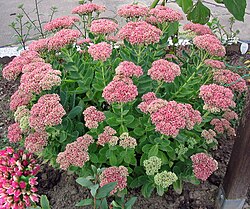Hylotelephium spectabile
| Habit | herbaceous
| |
|---|---|---|
| Height: | ⇕ | 27 in"in" can not be assigned to a declared number type with value 27. |
| Width: | ⇔ | 16 in"in" can not be assigned to a declared number type with value 16. to 32 in"in" can not be assigned to a declared number type with value 32. |
| Lifespan: | ⌛ | perennial |
| Bloom: | ❀ | early summer, mid summer, late summer, early fall, mid fall, late fall |
| Exposure: | ☼ | sun |
|---|---|---|
| Features: | ✓ | flowers |
| USDA Zones: | 6 to 10 | |
| Flower features: | ❀ | red, blue, purple, pink, white |
Hylotelephium spectabile (formerly called Sedum spectabile) is a plant in the stonecrop family, Crassulaceae. Its common names include showy stonecrop, ice plant, and butterfly stone crop.
Hylotelephium spectabile is a herbaceous plant with alternate, simple leaves, on succuulent stems. The flowers are pink, borne in fall.
Read about Hylotelephium spectabile in the Standard Cyclopedia of Horticulture
|
|---|
|
Sedum spectabile, Bor. (S. Fabaria, Hort., not Koch). Showy Sedum. Perennial, robust and glaucous: sts. 18-24 in.: lvs. opposite, decussate or in whorls of 3, 3x2 in., flat, scarcely petioled, ovate or spatulate, entire or obscurely sinuate-dentate: fls. numerous, 1/2 in. across, pink, in large flat-topped, inversely pyramidal, leafy and umbellate cymes; sepals whitish, linear-lanceolate; petals slightly concave; anthers orange. Japan (?).—The fls. are said to vary from rose to purple and perhaps to white. This is the showiest of the sedums and is an excellent border and garden plant. It is said to thrive best in stiff clay and not to do so well in lighter soils. Var. album, Hort., a white-fld. form is offered in the trade. Var. atropurpureum, Hort., is a form with rosy crimson fls. Var. purpureum, Hort., is offered in the trade. Var. roseum, Hort., is offered in the trade. Var. rubrum, Hort., is a form with crimson fls. There is also a form with variegated lvs. CH
|
Cultivation
Propagation
Pests and diseases
Varieties
Gallery
References
- Standard Cyclopedia of Horticulture, by L. H. Bailey, MacMillan Co., 1963
External links
- w:Hylotelephium spectabile. Some of the material on this page may be from Wikipedia, under the Creative Commons license.
- Hylotelephium spectabile QR Code (Size 50, 100, 200, 500)
